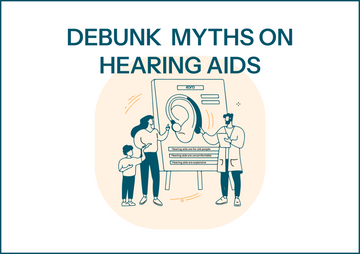Frequently Asked Questions
1. What are hearing aids and how do they work?
2. What types of hearing aids are available?
3. How can I improve my hearing experience in noisy environments?
4. What should I do in quiet environments to maintain comfort with my hearing aids?
5. How can I leverage technology with my Bluetooth OTC hearing aid?
The world is filled with diverse soundscapes, each presenting unique challenges and experiences for those who wear hearing aids. For individuals using devices such as a Bluetooth OTC hearing aid, adapting to change in various environments can significantly enhance their auditory experience and overall quality of life. This article delves into how hearing aids perform in different settings and offers practical tips for making the most of your device, ensuring you never miss a beat.
Understanding the Basics of Hearing Aids
Before diving into the complexities of different environments, let’s briefly explore what hearing aids are and how they function. Hearing aids are electronic devices that amplify sound, allowing individuals with hearing loss to engage more fully in conversations and enjoy music, television, and other audio experiences. With advancements in technology, many options now exist, including the innovative Bluetooth OTC hearing aid, which provides additional connectivity and features that can enhance everyday listening.
Types of Hearing Aids
There are various types of hearing aids designed to suit different needs and preferences:
- Behind-the-Ear (BTE): These devices rest behind the ear and are connected to a custom earpiece.
- In-the-Ear (ITE): ITE hearing aids are custom-made to fit in the outer ear, providing a discreet option.
- Receiver-in-Canal (RIC): These aids have a thin wire that connects the receiver to an earpiece, offering a more natural sound.
- Invisible-in-Canal (IIC): Placed deep inside the ear canal, these devices are virtually invisible.
Each type has its own advantages, but they all aim to facilitate clearer sound experiences in different environments.
Challenges in Noisy Environments
One of the most daunting situations for individuals using hearing aids is navigating noisy environments. Whether at bustling restaurants, crowded events, or public transportation, background noise can make it difficult to focus on conversations.
How Hearing Aids Help in Noisy Settings
Modern hearing aids, particularly Bluetooth OTC hearing aids, come equipped with noise reduction features. These functions help distinguish between background noise and relevant sounds, making conversations easier to hear. Here are a few strategies for optimizing hearing aid performance in noisy environments:
- Adjust Settings: Many hearing aids allow you to customize settings for specific environments. Take the time to experiment and find what works best.
- Use Noise-Cancellation Features: If your device has noise-cancellation options, ensure they are activated when in loud settings.
- Position Yourself Wisely: Try to sit closer to the people you want to hear and away from sound sources like speakers or crowded areas.
Enjoying Social Gatherings
Social gatherings are joyous occasions but can become challenging for those wearing hearing aids. Conversations happening simultaneously can lead to confusion and frustration. Here’s how to navigate these social situations effectively.
Tips for Successful Listening in Social Settings
Here are some tips to enhance your experience at social gatherings:
- Choose Acoustically-Friendly Spaces: If possible, select venues with softer furnishings and carpets to reduce echoes.
- Face the Speaker: Always ensure you’re facing the person you’re speaking with; lip-reading aids communication.
- Limit Overlapping Conversations: If you control the environment, work to keep group sizes manageable, allowing for clearer discourse.
Navigating Quiet Environments
While noisy environments pose their challenges, quiet settings can equally present issues for hearing aid users. In absolute silence, certain types of hearing aids may pick up internal sounds or create an echo effect, producing an uncomfortable auditory experience.
Maintaining Comfort in Quiet Spaces
For quieter environments, here are some tips:
- Adjust Volume Levels: In completely quiet surroundings, it may be beneficial to lower the volume on your hearing aids to avoid amplifying background noise.
- Switch to Different Listening Modes: Many Bluetooth OTC hearing aids allow you to switch to a mode designed for quiet places. Familiarize yourself with these settings.
- Consider Ambient Sounds: If you find complete silence unsettling, consider using relaxing ambient noise apps that can help mask unwanted sounds.
Adapting to Outdoor Environments
Outdoor settings present unique challenges for hearing aid users. Wind interference, unpredictable noises, and changing acoustics can complicate the listening experience.
Tips for Outdoor Experiences
Here are some strategies to enhance your auditory experience outdoors:
- Wind Noise Reduction: Many modern hearing aids are designed with wind noise reduction features. Be sure they are activated when headed outside.
- Stay Aware of Your Surroundings: When walking in outdoor environments, be mindful of changes in sound that might require your attention, like approaching vehicles.
- Keep Your Hearing Aids Protected: Use protective gear or silicone covers to shield your devices from moisture and dust.
The Importance of Regular Maintenance
Regular maintenance of your hearing aids is crucial for optimal performance in any environment. Clean your devices as prescribed, and schedule regular check-ups with your audiologist to ensure everything is functioning correctly.
Everyday Care Tips
- Daily Cleaning: Make it a habit to clean your hearing aids with a soft cloth and brush daily.
- Battery Management: Keep batteries charged and replace them as needed, especially before events or activities.
- Store Properly: When not in use, store your devices in a dry and safe place.
Utilizing Technology to Enhance Your Listening Experience
The rise of technology has dramatically influenced the capabilities of hearing aids. Innovations like Bluetooth connect hearing aids directly to smartphones, tablets, and other devices, providing versatility in different environments.
Leveraging Bluetooth Connectivity
If you have a Bluetooth OTC hearing aid, consider the following:
- Stream Audio Directly: Many Bluetooth devices enable music, podcasts, or phone calls to be streamed directly into your hearing aids, allowing for seamless audio enjoyment.
- Use Accessibility Apps: Various apps are designed to enhance the functionality of hearing aids by allowing users to control settings at their fingertips.
- Group Conversations Features: Certain Bluetooth aids can be set to prioritize voices in a group, making it easier to connect even in crowded environments.
The Personal Touch: Customizing Your Auditory Journey
Every individual has their own unique hearing challenges and preferences. Thus, customization is key to optimizing your auditory experience. Work closely with your audiologist to tailor your hearing aids to your lifestyle and needs.
Consulting with Your Audiologist
Your audiologist can help you in various ways:
- Personalized Settings: Have your audiologist adjust the settings on your hearing aids to suit different environments.
- Regular Assessments: Regular check-ups allow any changes in your hearing to be monitored for timely adjustments.
- Transitioning Advice: Speak with them about tips for different enabling environments—what works well in one situation may not be best in another.
Empower Yourself to Connect
Hearing aids, specifically advanced options like Bluetooth OTC hearing aids, empower individuals to navigate the complexities of sound in varied environments. By understanding how different situations impact auditory experiences and adapting your devices accordingly, you can optimize your quality of life. Every conversation, laughter, or melody is within reach, waiting to be enjoyed. So, take charge of your auditory journey, make informed choices, and engage deeply with the world around you.

























